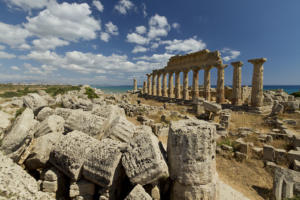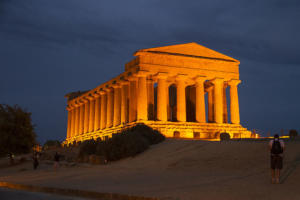
Traveling in Sicily is like reading an history book: from the big cities of Palermo and Catania, to the small towns scattered throughout the Island, from North to South, from East to West, every little corner of this land is able to tell locals and tourists something new and incredible about the dominations and civilizations that have succeed one another over the centuries.
The stunning archaeological sites in Sicily represent the tiles of the enchanting great mosaic of Sicilian history and, thanks to their breathtaking beauty and importance, most of them have been listed as UNESCO World Heritage Sites, boasting an international reputation. That’s why they have become must see attractions of every travel itinerary in Sicily. Take a look at our suggestive selection of Villas in Sicily near the UNESCO Sites to find the best accommodation for your summer holidays in Sicily!
There are several imposing archaeological sites in Sicily. Today we want to dwell more on the beauties located in Western Sicily:
Selinunte is the largest Archaeological park in Europe. Here you will find some of our best Selinunte Villas: take a look at the full catalogue! The city was built in the 7th century BC and it was one of the most important centres of this area of the Island. The archaeological remains of Selinunte show a mixed style, both punic and greek: the main one is surely the ancient Acropolis, located in the center of the archaeological park, with the rests of the old temples, fortifications, the sanctuaries and numerous necropolises. Selinunte is a magical spot from which you can admire both the historical and naturalistic sides of Sicily: the park is located near the Belice Nature Reserve, one of the most beautiful nature reserves of the Island.
Selinunte was always the long term rival of the nearby Segesta, another Greek colony still located in the Trapani’s area. Founded by the Elymians in the 12th century BC., Segesta still preserves a stunning Doric Temple built in the 5th century BC and a majestic amphitheatre set on hilltop overlooking the whole city. Segesta was destroyed by the Vandals and the Saracens in the 5th century AC. The archaeological site of Segesta is surrounded by the typical Mediterranean vegetation and by a splendid, peaceful and romantic athmosphere.
The ancient Phoenician city of Mozia still preserves fortifications and buildings of the old necropolis. Mozia was a very powerful city located on an island renamed San Pantaleo, between Trapani and Marsala, in the Stagnone Nature Reserve: an enchanting protected site that surely worth a visit! A heavenly place where flora and fauna are protagonists and the perfect travel destination for kite surf lovers. Among the ruines of Mozia’s old centre tourists can observe ancient fortresses, walls and city gates, the kothon – a sacred pool connected with the adjacent temple – an archaic necropolis and the Sanctuary where the famous “Efebo di Mozia” statue was found.

How not to mention the most outstanding one: the Valley of the Temples, of course! Undisputed treasure of this gorgeous Island, the Valley of the Temples is UNESCO World Heritage Site since 1997. Ten doric temples (don’t miss the Temple of Concordia and the Temple of Heracles, respectively the most well-preserved and the most ancient one), two agorà, three sanctuaries, a Roman settlement, the garden of Kolymbetra: a marvellous variety of evidence of old Akragas’s glorious past. We recommend you to book one of our enchanting Villas in Sicily near the Vally of the Temples to stay within a short distance from the most impressive archaeological park in the world!
Last but not least the sites of Heraclea Minoa and Monte Iato where you can discover the remains of the old Greek city centres and two theatres.
Get ready for your journey into history with Scent of Sicily!
Top picture: Selinunte. Author: Franck Manogil. Source: Wikipedia.
Right picture: Temple of Concordia by night. Author: General Cucombre. Source: Wikipedia.

